 Storing your valuables properly is important. You've spent years collecting all your antiques, jewelry and art, so it would make sense to take the time to properly store all those expensive or priceless items. After your move is the perfect opportunity to find new ways to store your items and keep them secure.
Storing your valuables properly is important. You've spent years collecting all your antiques, jewelry and art, so it would make sense to take the time to properly store all those expensive or priceless items. After your move is the perfect opportunity to find new ways to store your items and keep them secure.
How to store your valuables
Jewelry: Fine jewelry storage preserves jewelry and helps it to retain its value. Selecting the right type of jewelry box or storage system will help extend the life of your precious pieces. Generally speaking, jewelry is best kept in its original package whenever possible, but if that isn't an option, a jewelry box is recommended.
-
Choose a jewelry box with a sturdy exterior and soft interior: It should be able to defend against external pressure to prevent damage by the surrounding elements and the soft interior will be able to protect the item from damage and help it retain its luster.
-
Use Zip-Lock bags when traveling: People who travel frequently do not have to be without their favorite accessories. The bags will help keep the items from becoming damaged during your trip. They also take up less space and are transparent so you can see what you're bringing.
-
Store each type of item separately: Keep earrings separate from your necklaces to prevent knotting. Storing each necklace separate will prevent any tangles and inevitable kinks or breaks in the chains.
-
Store your jewelry in a dry place: Humidity can damage fine jewelry. Make sure your fine jewelry items are kept in a cool, dry place.
Fine art
After unpacking your collection of artwork, there are things to keep in mind when storing them or displaying them throughout your new home.
-
Hire a professional art hanger: Objects must be hung correctly to ensure support and reduce the chance of falling. A professional is more likely to use the proper hardware than a general contractor. Also, DO NOT hang your art above a fireplace. Heat, smoke and ash can easily ruin your precious artwork.
-
Keep your home at a constant temperature: The ideal climate for valuable objects is between 65-75 degrees Fahrenheit (18-21 degrees Celsius) and a 47-55 percent relative humidity. Store your art in a location that is clear from outside air flow including vents, doors and windows.
-
Keep art collections out of direct sunlight: The ultraviolet light will cause severe and irreversible damage to the art especially to paper, textiles and photos. To prevent fading, it's a good idea to rotate your collection regularly.
-
Do not store fine art in basements or attics: Due to the close proximity of the building exterior, basements and attics are susceptible to dramatic temperature changes, flooding, insects and rodents. Store the artwork in a centralized room or designated dry space. If possible, create an "art closet" with horizontal racks and a locked door.
Antiques
Collectors might not see themselves this way, but you are the curator of your personal collection.
-
Avoid light: Light can harm almost any collectible, especially organic materials like wood, paper and textiles. Harsh light can not only fade colors in prints, but it can also dry out many materials and can speed up chemical reactions that occur naturally over time.
-
Control humidity: When there's not enough humidity, items like paintings, wood and paper can shrink, crack and become brittle. When humidity reaches excessive levels, rust can develop on metal items, mold can grow on objects and insects are encouraged to breed.
-
Change climates gradually: If you decide to change the way you are storing items, moving from hot to cold and vice versa, do so gradually. Most antiques can be shocked when exposed to temperature extremes too quickly. Tiny cracks in ceramic glazes can appear more rapidly than they would have naturally, for example.
Things to consider when hiding valuables
Concealing these items can be difficult, obviously if you are trying to conceal larger pieces. However, when thinking of places to store jewelry and smaller items, the trick is to think like a thief. Go through your home with the mindset of a burglar, the first few places you go to look for some kind of valuable is usually the first place a burglar will look also.
If you want to hide something long-term, you should invest in a good quality safe. It may draw attention, but it is still more secure than hiding it somewhere obscure. Thieves will tear apart your entire home if they have enough time, a high-quality safe will need time to open and get into, and if it is bolted down it will take time to remove it entirely.
TIP: If it's difficult for you to get to it, it will be difficult for a thief or burglar too.
If you're looking for a short-term hiding spot, DO NOT put valuables in an obvious location such as:
Keeping your valuables safe is important. You should have your items appraised and insured if applicable and make sure to keep all the supporting documents together either in a safe place at home or in a safety deposit box at a bank.